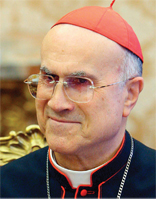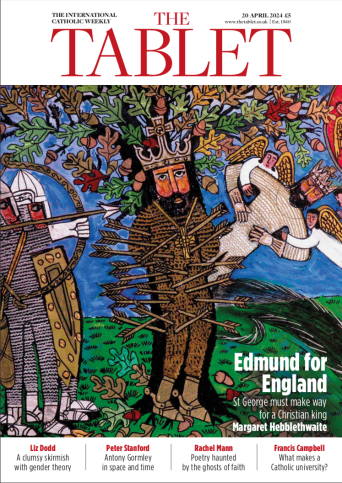It has become a ritual in Rome in July for the Holy See to release a financial statement from Istituto per le Opere di Religione (IOR) – the Institute for Religious Works, popularly known as the Vatican bank. The data just disclosed by IOR on the 2013 fiscal year, accompanied by comments from Ernst von Freyberg, president of the Board of Superintendence, offers an encouraging view of progress under Pope Francis in putting the scandal-plagued bank back into shape and getting it ready for reform.
The numbers tell a story, but more as a footnote to an unfolding narrative of institutional change and the personalities involved.
The Vatican has also announced that a scaled-back IOR will no longer do asset management, the milk and whisky of investment banking, and this will instead be handed to a special organisation, Vatican Asset Management.
The IOR will come under a new executive team in the Secretariat of the Economy, which Pope Francis created, and entrusted to Australian Cardinal George Pell, as a means of downsizing the IOR’s role in the Roman Curia and strengthening accountability.
Putting the bank under a super-structure authority further restricts the latitude that IOR mid-level account managers once had.
For decades, IOR was a black hole of Vatican finances, an off-the-books asset that critics likened to an offshore bank, particularly after the Vatican paid a $250million (£146m) fine in 1985 to Italy for the IOR’s role in the collapse of the Mob-controlled Banco Ambrosiano.
John Paul II was famously detached from Curia infighting, and operations at the bank, which historically provided Popes with funds for their charitable uses, even as the bank itself made no public accounting.
In the final years of Benedict XVI’s papacy, the IOR came under escalating pressure from central banking authorities of the European Union and Italy to halt servicing privileged clients suspected of money-laundering.
In 2010, the Financial Times reported that the IOR had “an unknown number of private Italian account holders who use the Vatican as a tax haven”. An unnamed Italian official told the newspaper, “That is the mechanism we are trying to dismantle.”
In one of Benedict’s last and most important decisions, in February 2013 he appointed von Freyberg, a German industrialist and member of the Sovereign Order of Malta, to oversee the bank.
Von Freyberg replaced Ettore Gotti Tedeschi, an economics professor and Opus Dei member who had come highly touted, but ran foul of the powerful Secretary of State, Cardinal Tarcisio Bertone.
Though prized by Benedict for his loyalty, Bertone resisted halting the cosy way that IOR managers had done business, particularly with a dense network of relatives and friends of Italian church officials.
Bertone clashed with Archbishop Carlo Maria Viganò, deputy governor of the Vatican City State from 2009-2011. Viganò was that rare figure – a committed reformer – in a curial culture that was torn by Balkanised feuding. Benedict had established a financial oversight committee for IOR, under pressure from Italian banking authorities for greater transparency. But as Benedict worked on the final volume of his biography of Jesus, he grew more detached from daily operations of the Curia, relying on Bertone for hands-on governing.
Viganò, meanwhile, was cancelling contracts with Vatican City State vendors for padded invoices, digging deeper into financial irregularities in the operations, and turning the deficit his office inherited into a surplus.
Then Bertone got rid of him, using a silk-between-the fingers demotion. He sent Viganò to Washington as papal nuncio, a dream position for many clerical careerists. But not for Viganò, who protested in a letter to Benedict, laying out the case for keeping his job, citing hard work still to do in cleaning up the financial mess. To no avail.
In 2013, Viganò’s letter was published among the many documents that made headlines in Vatileaks coverage after the papal valet, Paolo Gabriele, leaked boxes of material to the journalist Gianluigi Nuzzi.
Vatileaks devastated Benedict; but the real target was Bertone, a former canon lawyer at the Congregation for the Doctrine of the Faith under then-Cardinal Ratzinger, who had no experience in the Secretariat of State, which runs the Vatican, until his appointment. Bertone had few internal allies. “He compounded his problems by overreaching power, pushing allies into key positions and inserting his voice on matters only tangentially in his purview,” says Gerald Posner, an American investigative journalist and author of a forthcoming book, God’s Bankers, a history of Vatican finances.
Although evidence at Gabriele’s trial was limited by the judge, the deceit was clear: Gabriele was a conduit for documents amassed by higher authorities out to damage Bertone, if not the Pope. But instead of firing Bertone, Benedict announced his own retirement.
“The story beneath these IOR reforms is the rehabilitation of Viganò,” insists Posner, the author of Case Closed, the definitive account of the JFK assassination. “Viganò was clearly on to something. It’s not as though he had entrenched cronies. It is impossible to imagine a letter from someone like Viganò going to Pope Francis and having him ignore it. Since Benedict’s departure, the IOR has been moving out people in key positions of influence allied to Bertone.”
Benedict had begun the shift towards IOR oversight with the September 2012 appointment of René Bruelhart, a Swiss lawyer with expertise in money-laundering, to run the Vatican’s Financial Information Authority – the oversight committee set up in 2010.
Bruelhart began implementing reforms recommended in a voluminous report on Holy See finances by Moneyval – shorthand for the Committee of Experts on the Evaluation of Anti-Money Laundering Measures and the Financing of Terrorism of the Council of Europe.
But the IOR still had its share of rot. In July last year, on the day that Pope Francis named a five-member commission to dig into the bank’s murky practices, a Vatican official, Mgr Nunzio Scarano, was arrested over his efforts to spirit €20m cash (£15.9m) out of Switzerland into Italy, evading currency laws. Scarano had help from a financial broker and an Italian secret service agent. The broker got cold feet. Scarano had already paid the intelligence agent, Giovanni Maria Zito, €200,000 (£159,158) as 50 per cent on his fee; Zito had an Italian government airline ready for transport duty when intelligence agents arrested the three men. Scarano awaits trial on money-laundering charges.
Bruelhart and von Freyberg beefed up internal standards with help from Promontory Financial Group, a New York-based international consulting firm that specialises in assisting companies and organisations to meet regulatory standards. Several attempts by this writer for an interview with Promontory did not succeed. One can charitably assume that Promontory’s eye for bank clients that Moneyval might deem toxic had a role in the IOR announcement of 8 July that, as of 30 June, it had “terminated 3,000 customer relationships, in an orderly process”.
Bruelhart recently cemented a bilateral accord between the Vatican’s Financial Information Authority and the US Treasury’s Office of the Comptroller of the Currency, which regulates domestic and foreign banks. That is a far cry from 2010, when the Treasury warned JPMorgan Chase about dealing with IOR. Italian authorities impounded $30m (£17.5m) in transfers from IOR to separate J.P. Morgan Frankurt accounts on suspicion of money-laundering. The impounded funds were returned nearly a year later, as scandal thickened around the bank.
“It’s a question of internal transparency and credibility,” Bruelhart told Gregory J. Millman of The Wall Street Journal in a 20 May 2014 interview. “Why should we become members of the Egmont Group, the global organisation of financial intelligence? Why do we participate in Moneyval? These are the kind of elements which are important, about which we have to be clear and transparent.”
More changes are coming. Von Freyberg is stepping down. The French financier Jean-Baptiste de Franssu took over as president of IOR on Wednesday with a remit to strengthen the business, and focus on the key task of advising and paying the people who work for the Church, whether it is as clergy, in congregations, dioceses or as lay Vatican employees.
And so to the story of the numbers. The Holy See closed the year 2013 with a deficit of €24.5m (£19.4m), primarily because of its investments in a fluctuating gold market, the press office announced. But the autonomous governorate of the Vatican City State – Archbishop Viganò’s old stomping ground – closed with a €33m (£26m) profit. The IOR, “as it does each year, offered the Holy Father a significant sum in support of his apostolic and charitable ministry” – €50m (£39.7m). Combing the two financial statements, the Vatican ended 2013 with a profit of €10m (£7.9m). But much more than large sums of money have been at stake in all this – so has the reputation and credibility of the Church.
Jason Berry is the author of “Render unto Rome: the secret life of money in the Catholic Church”, which received the Investigative Reporters and Editors 2011 Best Book Award.





 Loading ...
Loading ...
What do you think?
You can post as a subscriber user...
User Comments (0)